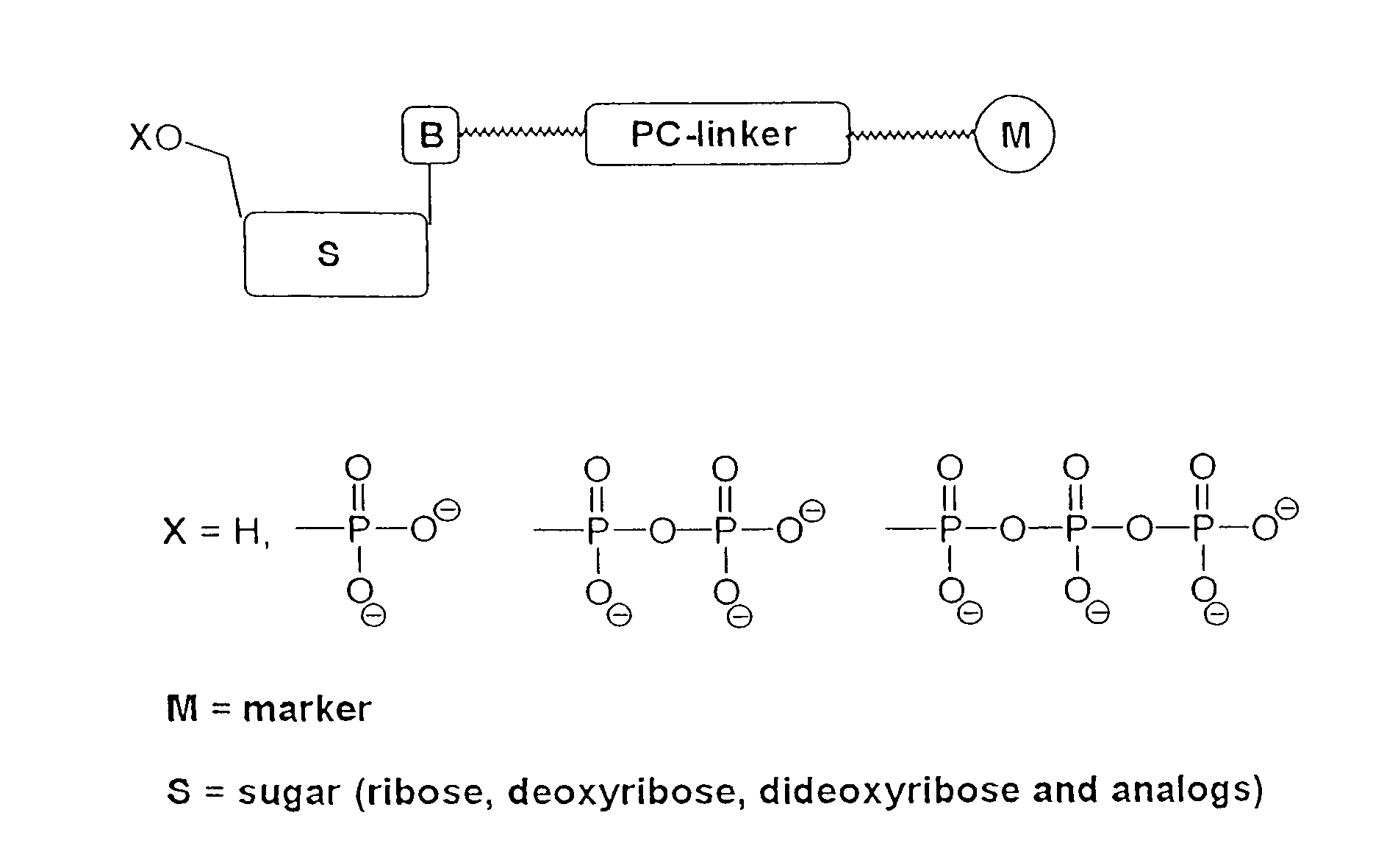Nucleotide compositions comprising photocleavable markers and methods of preparation thereof
a technology of photocleavage markers and compositions, which is applied in the field of nucleotides and polynucleotides, can solve the problems that the time-consuming electrophoresis step associated with these methods is difficult to perform in a highly parallel manner
- Summary
- Abstract
- Description
- Claims
- Application Information
AI Technical Summary
Benefits of technology
Problems solved by technology
Method used
Image
Examples
example 1
Synthesis of Photocleavable BODIPY-FL Deoxyuridine Triphosphate (BODIPY-FL-PC-aadUTP) (FIG. 3, 4)
[0102]In this example, one method for the production of the photocleavable marker-nucleotide conjugate, BODIPY-FL-PC-aadUTP (compound 6), is described.
[0103]A. Synthesis of Intermediate Compounds (Compounds 2, & 5)
[0104]Compound 1 (Olejnik, J., E. Krzymanska-Olejnik, and K. J. Rothschild. 1998. Methods Enzymol. 291:135-54) (100 mg, 0.19 mmol) was dissolved in anhydrous acetonitrile (10 ml) and to this solution 50 μl (0.285 mmol, 1.5 eq.) of N,N-diisopropylethylamine (DIPEA) (Sigma Cat. No. D 3887) was added followed by N,N′-disuccinimidyl carbonate (DSC) (Sigma Cat. No. D 3773) (75 mg, 0.285 mmol, 1.5 eq.). The mixture was stirred at room temperature overnight, volatile compounds removed under reduced pressure and the intermediate (compound 2) purified on a silica gel column using a step (0-1.5%) gradient of MeOH in CHCl3 with a yield of 500 mg (39%).
[0105]To make compound 5, 1 mg (1.9 μ...
example 2
Synthesis of Photocleavable Cy5 Deoxyuridine Triphosphate (Cy5-PC-aadUTP)
[0109]In this example, one method for the production of the photocleavable marker-nucleotide conjugate, Cy5-PC-aadUTP (compound 7), is described.
[0110]Compound 5 (0.24 μmol), as prepared above, was dissolved in 40 μl of 50 mM NaHCO3, followed by the addition of 0.72 μmol of a Cy5-NHS (Amersham-Pharnacia Biotech Cat. No. PA 25001) solution in 100 μl of DMF. The reaction mixture was incubated for 2 hours at room temperature and the product was isolated using RP-HPLC initially on R2 / 10 RP column (Perseptive Biosystems, 4.6×100 mm) followed by another purification on NovaPak C18, (Waters, 10×100 mm). In both case a gradient (0-90%) of acetonitrile in 50 mM triethylammonium acetate (pH 4.5) over 45 minutes with flow rate 1 ml / min. was used. Fractions containing the desired product were pooled and freeze-dried to give 60.5 nmoles of compound 7 (based on Cy5 fluorophore 550 nm absorption maximum, ε=250,000).
[0111]Comp...
example 3
Enzymatic Incorporation of BODIPY-FL-PC-aadUTP into DNA and Photocleavage
[0112]In this example, one method for the incorporation of photocleavable marker-nucleotide into a nucleic acid (or polynucleic acid) to form a photocleavable marker-polynucleotide conjugate is described. Although the example below specifies the usage of BODIPY-FL-PC-aadUTP, it is important to note that the present invention also contemplates a method for the incorporation of photocleavable marker-nucleotide into a nucleic acid (or polynucleic acid) to form a photocleavable marker-polynucleotide conjugate wherein Cy5-PC-aadUTP is substituted in place of BODIPY-FL-PC-aadUTP (i.e. the method below will work equally well with either photocleavable marker nucleotide).
[0113]The enzymatic incorporation of a photocleavable marker-nucleotide into the oligonucleotide was performed using components of commercially available kit (Amersham-Pharmacia Biotech, Gene Images 3′-oligolabeling kit, Cat. No. RPN 5770) per the manu...
PUM
 Login to View More
Login to View More Abstract
Description
Claims
Application Information
 Login to View More
Login to View More - R&D
- Intellectual Property
- Life Sciences
- Materials
- Tech Scout
- Unparalleled Data Quality
- Higher Quality Content
- 60% Fewer Hallucinations
Browse by: Latest US Patents, China's latest patents, Technical Efficacy Thesaurus, Application Domain, Technology Topic, Popular Technical Reports.
© 2025 PatSnap. All rights reserved.Legal|Privacy policy|Modern Slavery Act Transparency Statement|Sitemap|About US| Contact US: help@patsnap.com



